ITECH 7400: Robotic Surgery Ethics and Professional Culture Analysis
VerifiedAdded on 2022/07/28
|8
|1861
|20
Discussion Board Post
AI Summary
This discussion board post critically analyzes the ethical dimensions of robotic surgery, exploring the roles and responsibilities of IT professionals within this context. The post begins by outlining four key ethical perspectives: utilitarianism, character-based ethics, social contract theory, and deontology, and applies each to the scenario of robotic surgery. It examines how these theories shape the accountability of IT professionals in cases of technical failures or disruptions during surgery. The post also references the ACS code of ethics, particularly its emphasis on enhancing the quality of life, to further define the extent of IT professionals' responsibility in ensuring accuracy and patient safety. It concludes by highlighting the benefits of robotic surgery while emphasizing the critical role IT professionals play in its ethical and technical execution, including providing guidance to surgeons and ensuring the robots' reliability through regular checks. The assignment references multiple sources to support the analysis.
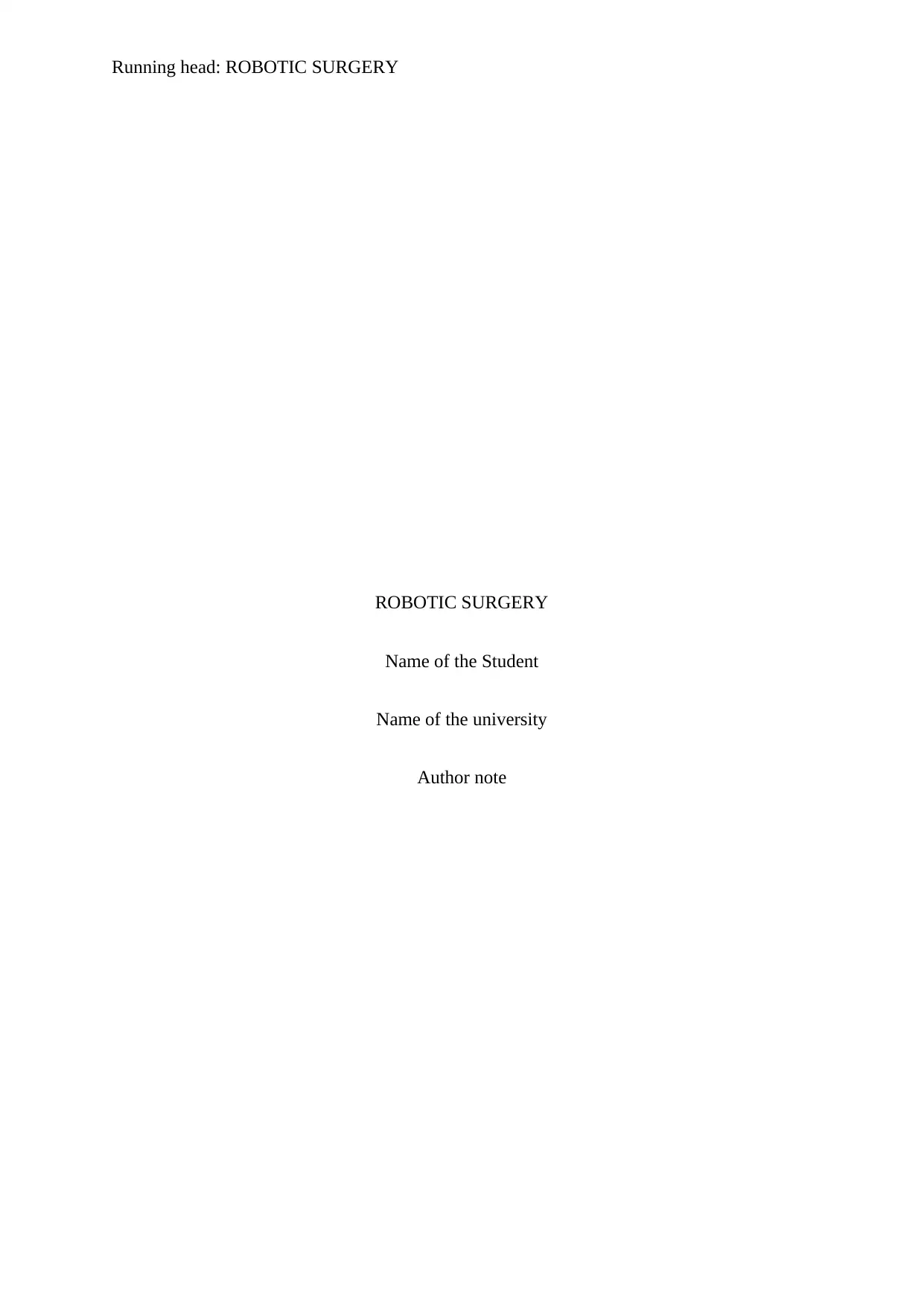
Running head: ROBOTIC SURGERY
ROBOTIC SURGERY
Name of the Student
Name of the university
Author note
ROBOTIC SURGERY
Name of the Student
Name of the university
Author note
Paraphrase This Document
Need a fresh take? Get an instant paraphrase of this document with our AI Paraphraser
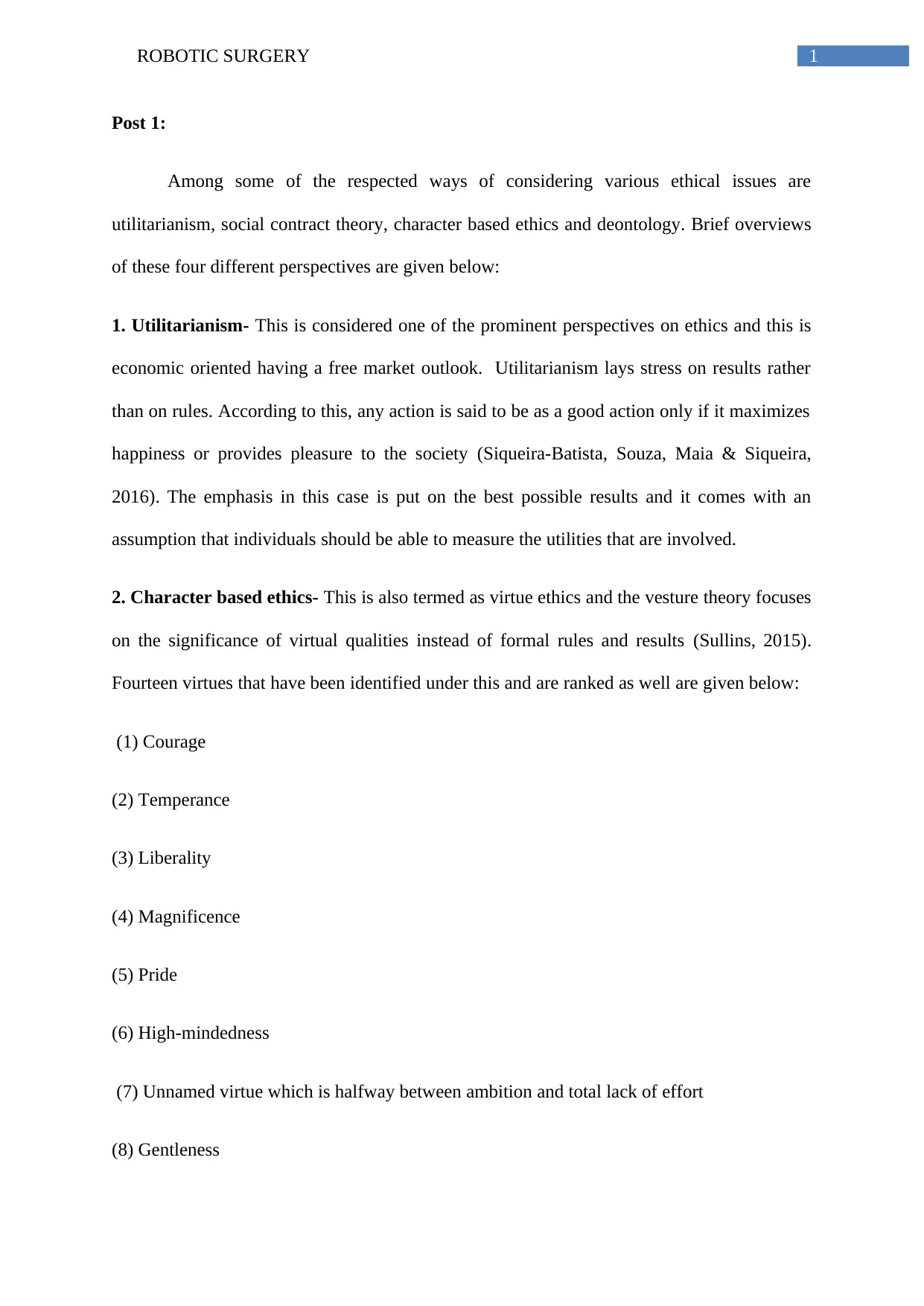
1ROBOTIC SURGERY
Post 1:
Among some of the respected ways of considering various ethical issues are
utilitarianism, social contract theory, character based ethics and deontology. Brief overviews
of these four different perspectives are given below:
1. Utilitarianism- This is considered one of the prominent perspectives on ethics and this is
economic oriented having a free market outlook. Utilitarianism lays stress on results rather
than on rules. According to this, any action is said to be as a good action only if it maximizes
happiness or provides pleasure to the society (Siqueira-Batista, Souza, Maia & Siqueira,
2016). The emphasis in this case is put on the best possible results and it comes with an
assumption that individuals should be able to measure the utilities that are involved.
2. Character based ethics- This is also termed as virtue ethics and the vesture theory focuses
on the significance of virtual qualities instead of formal rules and results (Sullins, 2015).
Fourteen virtues that have been identified under this and are ranked as well are given below:
(1) Courage
(2) Temperance
(3) Liberality
(4) Magnificence
(5) Pride
(6) High-mindedness
(7) Unnamed virtue which is halfway between ambition and total lack of effort
(8) Gentleness
Post 1:
Among some of the respected ways of considering various ethical issues are
utilitarianism, social contract theory, character based ethics and deontology. Brief overviews
of these four different perspectives are given below:
1. Utilitarianism- This is considered one of the prominent perspectives on ethics and this is
economic oriented having a free market outlook. Utilitarianism lays stress on results rather
than on rules. According to this, any action is said to be as a good action only if it maximizes
happiness or provides pleasure to the society (Siqueira-Batista, Souza, Maia & Siqueira,
2016). The emphasis in this case is put on the best possible results and it comes with an
assumption that individuals should be able to measure the utilities that are involved.
2. Character based ethics- This is also termed as virtue ethics and the vesture theory focuses
on the significance of virtual qualities instead of formal rules and results (Sullins, 2015).
Fourteen virtues that have been identified under this and are ranked as well are given below:
(1) Courage
(2) Temperance
(3) Liberality
(4) Magnificence
(5) Pride
(6) High-mindedness
(7) Unnamed virtue which is halfway between ambition and total lack of effort
(8) Gentleness
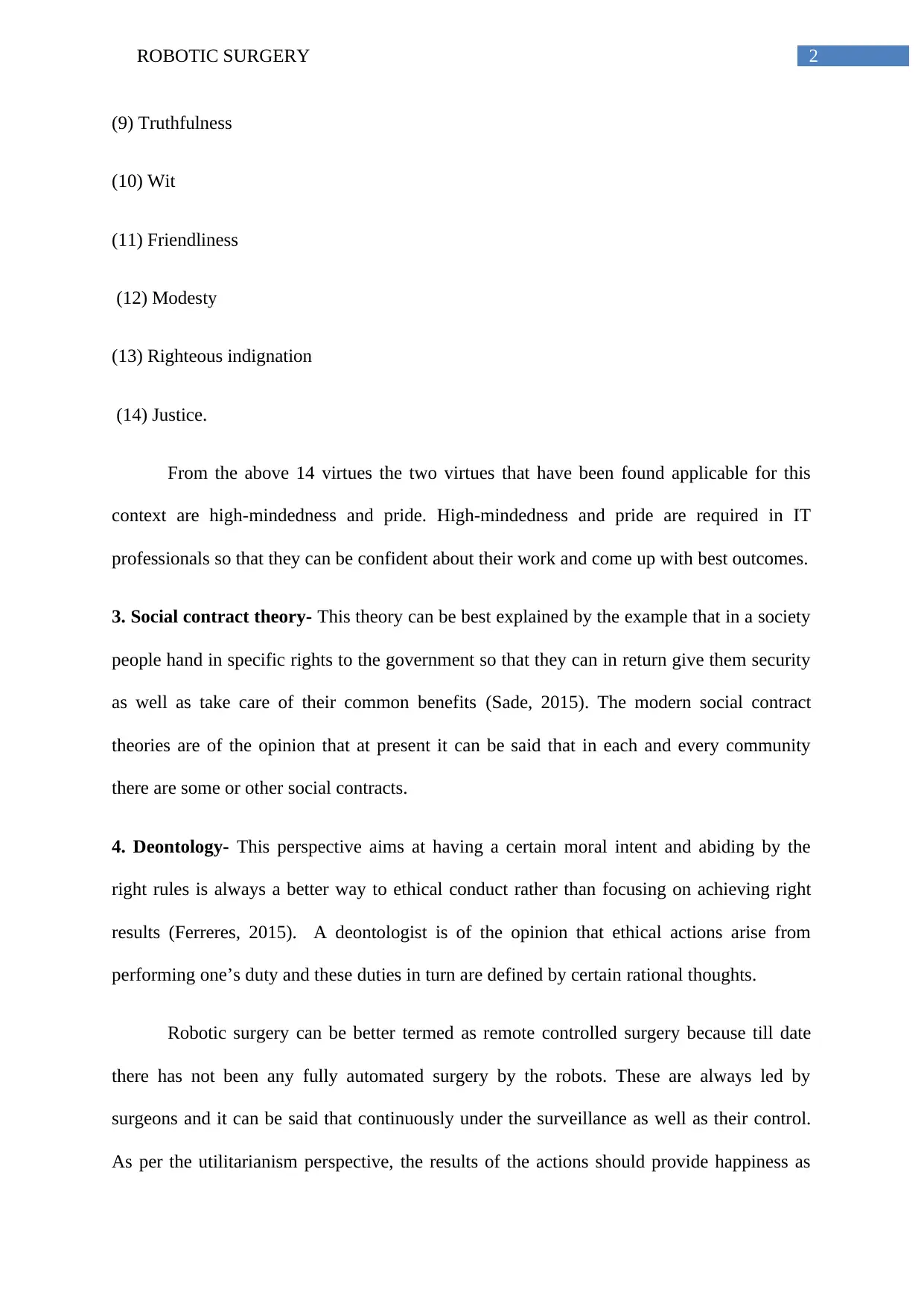
2ROBOTIC SURGERY
(9) Truthfulness
(10) Wit
(11) Friendliness
(12) Modesty
(13) Righteous indignation
(14) Justice.
From the above 14 virtues the two virtues that have been found applicable for this
context are high-mindedness and pride. High-mindedness and pride are required in IT
professionals so that they can be confident about their work and come up with best outcomes.
3. Social contract theory- This theory can be best explained by the example that in a society
people hand in specific rights to the government so that they can in return give them security
as well as take care of their common benefits (Sade, 2015). The modern social contract
theories are of the opinion that at present it can be said that in each and every community
there are some or other social contracts.
4. Deontology- This perspective aims at having a certain moral intent and abiding by the
right rules is always a better way to ethical conduct rather than focusing on achieving right
results (Ferreres, 2015). A deontologist is of the opinion that ethical actions arise from
performing one’s duty and these duties in turn are defined by certain rational thoughts.
Robotic surgery can be better termed as remote controlled surgery because till date
there has not been any fully automated surgery by the robots. These are always led by
surgeons and it can be said that continuously under the surveillance as well as their control.
As per the utilitarianism perspective, the results of the actions should provide happiness as
(9) Truthfulness
(10) Wit
(11) Friendliness
(12) Modesty
(13) Righteous indignation
(14) Justice.
From the above 14 virtues the two virtues that have been found applicable for this
context are high-mindedness and pride. High-mindedness and pride are required in IT
professionals so that they can be confident about their work and come up with best outcomes.
3. Social contract theory- This theory can be best explained by the example that in a society
people hand in specific rights to the government so that they can in return give them security
as well as take care of their common benefits (Sade, 2015). The modern social contract
theories are of the opinion that at present it can be said that in each and every community
there are some or other social contracts.
4. Deontology- This perspective aims at having a certain moral intent and abiding by the
right rules is always a better way to ethical conduct rather than focusing on achieving right
results (Ferreres, 2015). A deontologist is of the opinion that ethical actions arise from
performing one’s duty and these duties in turn are defined by certain rational thoughts.
Robotic surgery can be better termed as remote controlled surgery because till date
there has not been any fully automated surgery by the robots. These are always led by
surgeons and it can be said that continuously under the surveillance as well as their control.
As per the utilitarianism perspective, the results of the actions should provide happiness as
⊘ This is a preview!⊘
Do you want full access?
Subscribe today to unlock all pages.

Trusted by 1+ million students worldwide
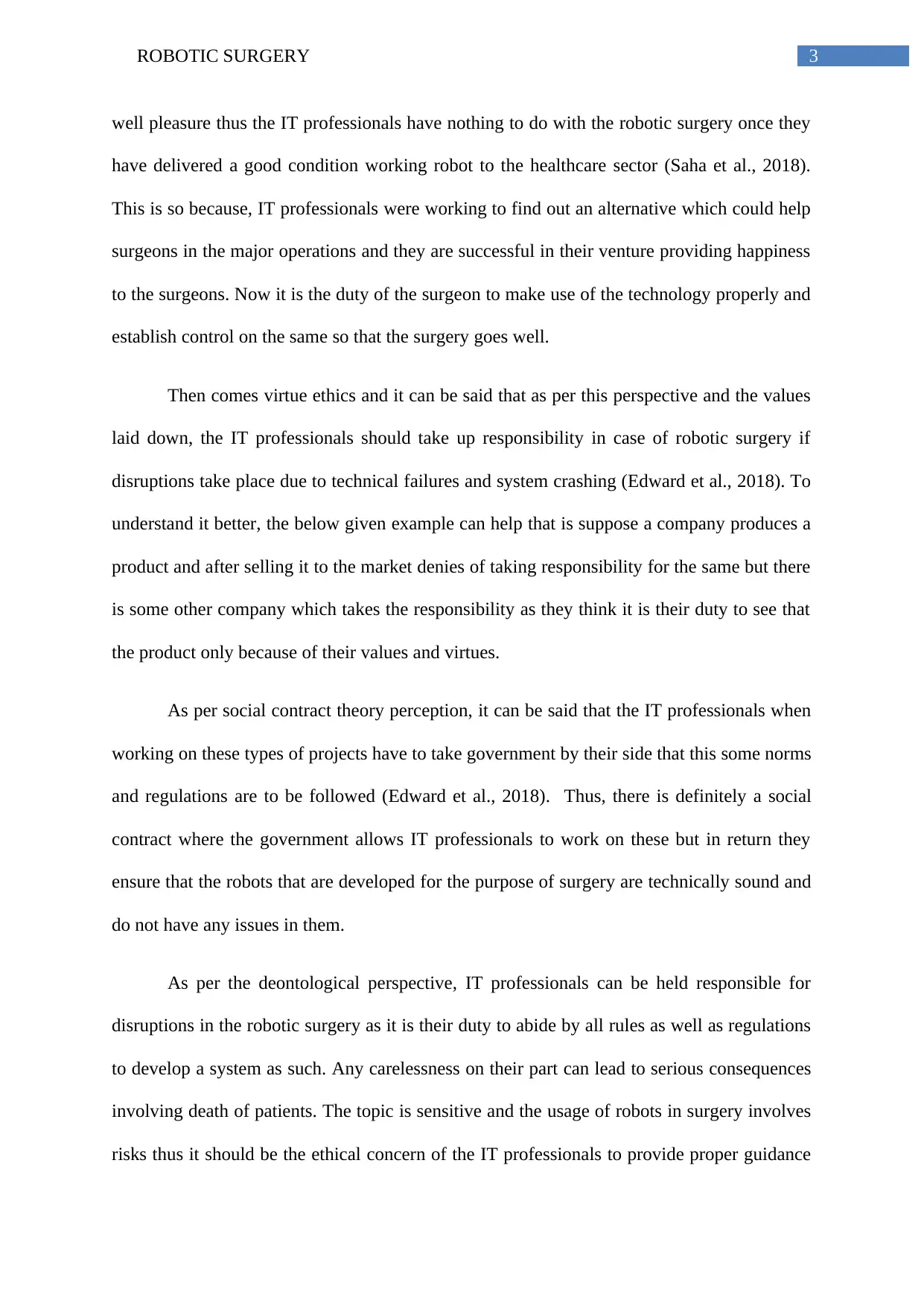
3ROBOTIC SURGERY
well pleasure thus the IT professionals have nothing to do with the robotic surgery once they
have delivered a good condition working robot to the healthcare sector (Saha et al., 2018).
This is so because, IT professionals were working to find out an alternative which could help
surgeons in the major operations and they are successful in their venture providing happiness
to the surgeons. Now it is the duty of the surgeon to make use of the technology properly and
establish control on the same so that the surgery goes well.
Then comes virtue ethics and it can be said that as per this perspective and the values
laid down, the IT professionals should take up responsibility in case of robotic surgery if
disruptions take place due to technical failures and system crashing (Edward et al., 2018). To
understand it better, the below given example can help that is suppose a company produces a
product and after selling it to the market denies of taking responsibility for the same but there
is some other company which takes the responsibility as they think it is their duty to see that
the product only because of their values and virtues.
As per social contract theory perception, it can be said that the IT professionals when
working on these types of projects have to take government by their side that this some norms
and regulations are to be followed (Edward et al., 2018). Thus, there is definitely a social
contract where the government allows IT professionals to work on these but in return they
ensure that the robots that are developed for the purpose of surgery are technically sound and
do not have any issues in them.
As per the deontological perspective, IT professionals can be held responsible for
disruptions in the robotic surgery as it is their duty to abide by all rules as well as regulations
to develop a system as such. Any carelessness on their part can lead to serious consequences
involving death of patients. The topic is sensitive and the usage of robots in surgery involves
risks thus it should be the ethical concern of the IT professionals to provide proper guidance
well pleasure thus the IT professionals have nothing to do with the robotic surgery once they
have delivered a good condition working robot to the healthcare sector (Saha et al., 2018).
This is so because, IT professionals were working to find out an alternative which could help
surgeons in the major operations and they are successful in their venture providing happiness
to the surgeons. Now it is the duty of the surgeon to make use of the technology properly and
establish control on the same so that the surgery goes well.
Then comes virtue ethics and it can be said that as per this perspective and the values
laid down, the IT professionals should take up responsibility in case of robotic surgery if
disruptions take place due to technical failures and system crashing (Edward et al., 2018). To
understand it better, the below given example can help that is suppose a company produces a
product and after selling it to the market denies of taking responsibility for the same but there
is some other company which takes the responsibility as they think it is their duty to see that
the product only because of their values and virtues.
As per social contract theory perception, it can be said that the IT professionals when
working on these types of projects have to take government by their side that this some norms
and regulations are to be followed (Edward et al., 2018). Thus, there is definitely a social
contract where the government allows IT professionals to work on these but in return they
ensure that the robots that are developed for the purpose of surgery are technically sound and
do not have any issues in them.
As per the deontological perspective, IT professionals can be held responsible for
disruptions in the robotic surgery as it is their duty to abide by all rules as well as regulations
to develop a system as such. Any carelessness on their part can lead to serious consequences
involving death of patients. The topic is sensitive and the usage of robots in surgery involves
risks thus it should be the ethical concern of the IT professionals to provide proper guidance
Paraphrase This Document
Need a fresh take? Get an instant paraphrase of this document with our AI Paraphraser
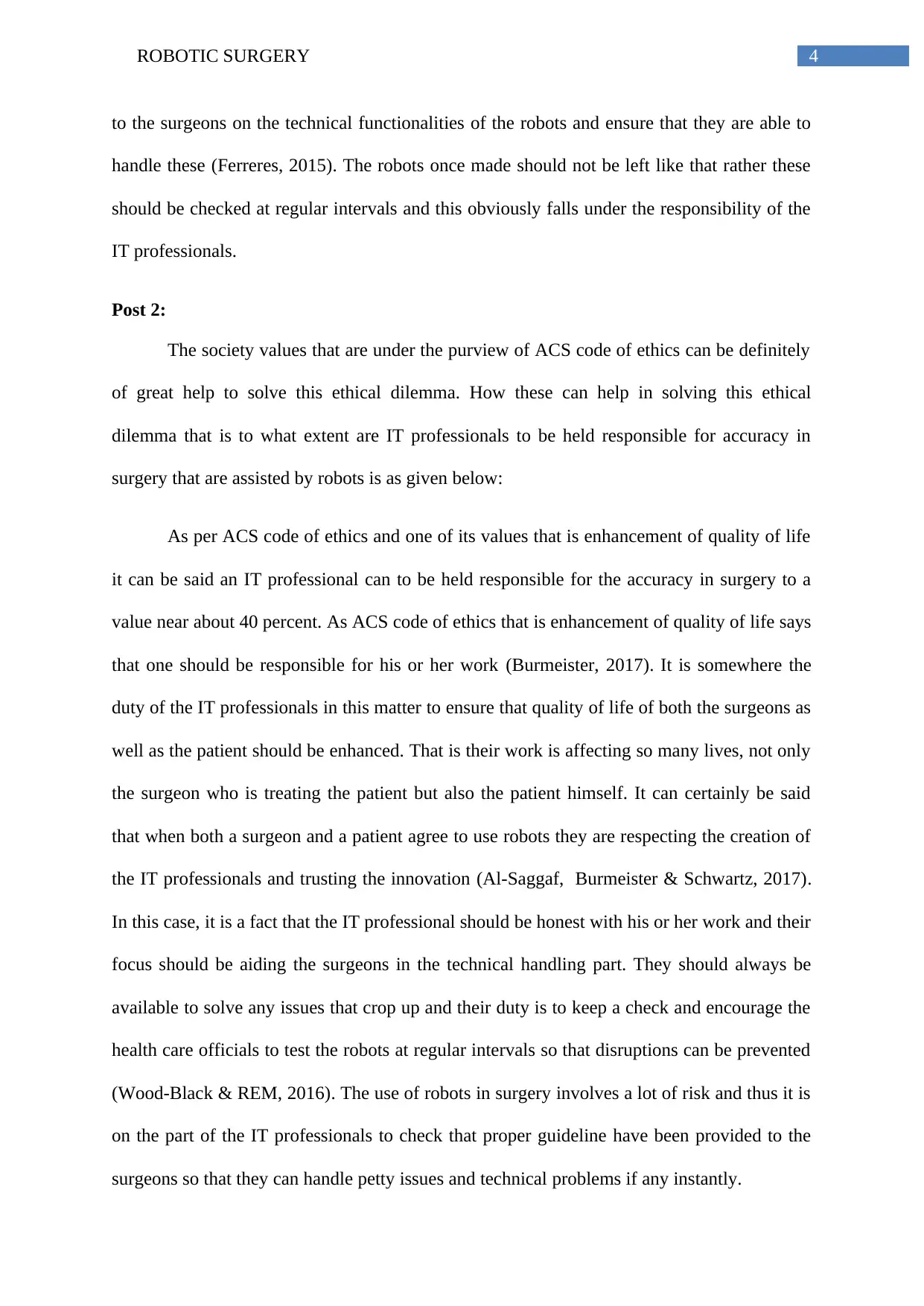
4ROBOTIC SURGERY
to the surgeons on the technical functionalities of the robots and ensure that they are able to
handle these (Ferreres, 2015). The robots once made should not be left like that rather these
should be checked at regular intervals and this obviously falls under the responsibility of the
IT professionals.
Post 2:
The society values that are under the purview of ACS code of ethics can be definitely
of great help to solve this ethical dilemma. How these can help in solving this ethical
dilemma that is to what extent are IT professionals to be held responsible for accuracy in
surgery that are assisted by robots is as given below:
As per ACS code of ethics and one of its values that is enhancement of quality of life
it can be said an IT professional can to be held responsible for the accuracy in surgery to a
value near about 40 percent. As ACS code of ethics that is enhancement of quality of life says
that one should be responsible for his or her work (Burmeister, 2017). It is somewhere the
duty of the IT professionals in this matter to ensure that quality of life of both the surgeons as
well as the patient should be enhanced. That is their work is affecting so many lives, not only
the surgeon who is treating the patient but also the patient himself. It can certainly be said
that when both a surgeon and a patient agree to use robots they are respecting the creation of
the IT professionals and trusting the innovation (Al-Saggaf, Burmeister & Schwartz, 2017).
In this case, it is a fact that the IT professional should be honest with his or her work and their
focus should be aiding the surgeons in the technical handling part. They should always be
available to solve any issues that crop up and their duty is to keep a check and encourage the
health care officials to test the robots at regular intervals so that disruptions can be prevented
(Wood-Black & REM, 2016). The use of robots in surgery involves a lot of risk and thus it is
on the part of the IT professionals to check that proper guideline have been provided to the
surgeons so that they can handle petty issues and technical problems if any instantly.
to the surgeons on the technical functionalities of the robots and ensure that they are able to
handle these (Ferreres, 2015). The robots once made should not be left like that rather these
should be checked at regular intervals and this obviously falls under the responsibility of the
IT professionals.
Post 2:
The society values that are under the purview of ACS code of ethics can be definitely
of great help to solve this ethical dilemma. How these can help in solving this ethical
dilemma that is to what extent are IT professionals to be held responsible for accuracy in
surgery that are assisted by robots is as given below:
As per ACS code of ethics and one of its values that is enhancement of quality of life
it can be said an IT professional can to be held responsible for the accuracy in surgery to a
value near about 40 percent. As ACS code of ethics that is enhancement of quality of life says
that one should be responsible for his or her work (Burmeister, 2017). It is somewhere the
duty of the IT professionals in this matter to ensure that quality of life of both the surgeons as
well as the patient should be enhanced. That is their work is affecting so many lives, not only
the surgeon who is treating the patient but also the patient himself. It can certainly be said
that when both a surgeon and a patient agree to use robots they are respecting the creation of
the IT professionals and trusting the innovation (Al-Saggaf, Burmeister & Schwartz, 2017).
In this case, it is a fact that the IT professional should be honest with his or her work and their
focus should be aiding the surgeons in the technical handling part. They should always be
available to solve any issues that crop up and their duty is to keep a check and encourage the
health care officials to test the robots at regular intervals so that disruptions can be prevented
(Wood-Black & REM, 2016). The use of robots in surgery involves a lot of risk and thus it is
on the part of the IT professionals to check that proper guideline have been provided to the
surgeons so that they can handle petty issues and technical problems if any instantly.
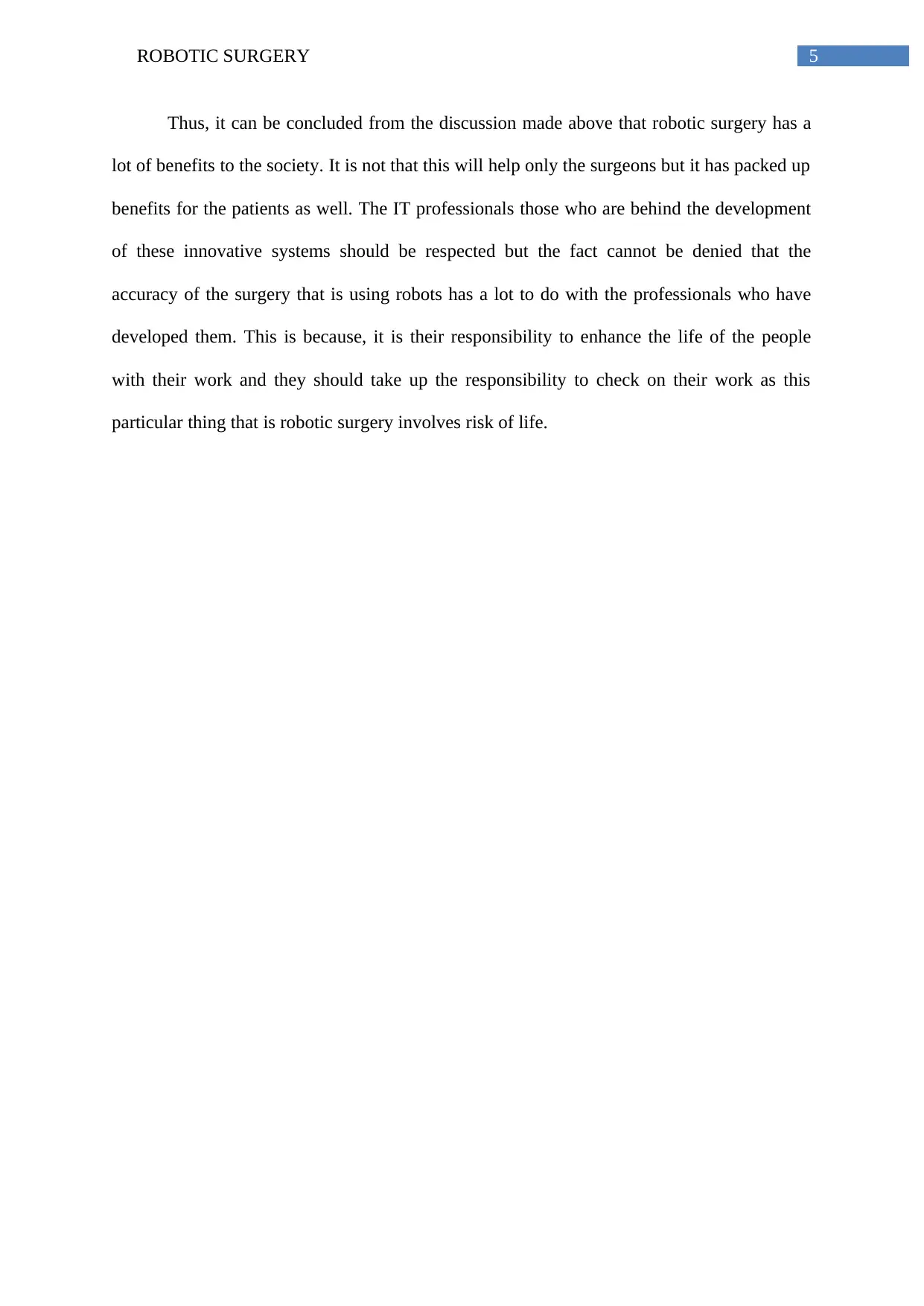
5ROBOTIC SURGERY
Thus, it can be concluded from the discussion made above that robotic surgery has a
lot of benefits to the society. It is not that this will help only the surgeons but it has packed up
benefits for the patients as well. The IT professionals those who are behind the development
of these innovative systems should be respected but the fact cannot be denied that the
accuracy of the surgery that is using robots has a lot to do with the professionals who have
developed them. This is because, it is their responsibility to enhance the life of the people
with their work and they should take up the responsibility to check on their work as this
particular thing that is robotic surgery involves risk of life.
Thus, it can be concluded from the discussion made above that robotic surgery has a
lot of benefits to the society. It is not that this will help only the surgeons but it has packed up
benefits for the patients as well. The IT professionals those who are behind the development
of these innovative systems should be respected but the fact cannot be denied that the
accuracy of the surgery that is using robots has a lot to do with the professionals who have
developed them. This is because, it is their responsibility to enhance the life of the people
with their work and they should take up the responsibility to check on their work as this
particular thing that is robotic surgery involves risk of life.
⊘ This is a preview!⊘
Do you want full access?
Subscribe today to unlock all pages.

Trusted by 1+ million students worldwide
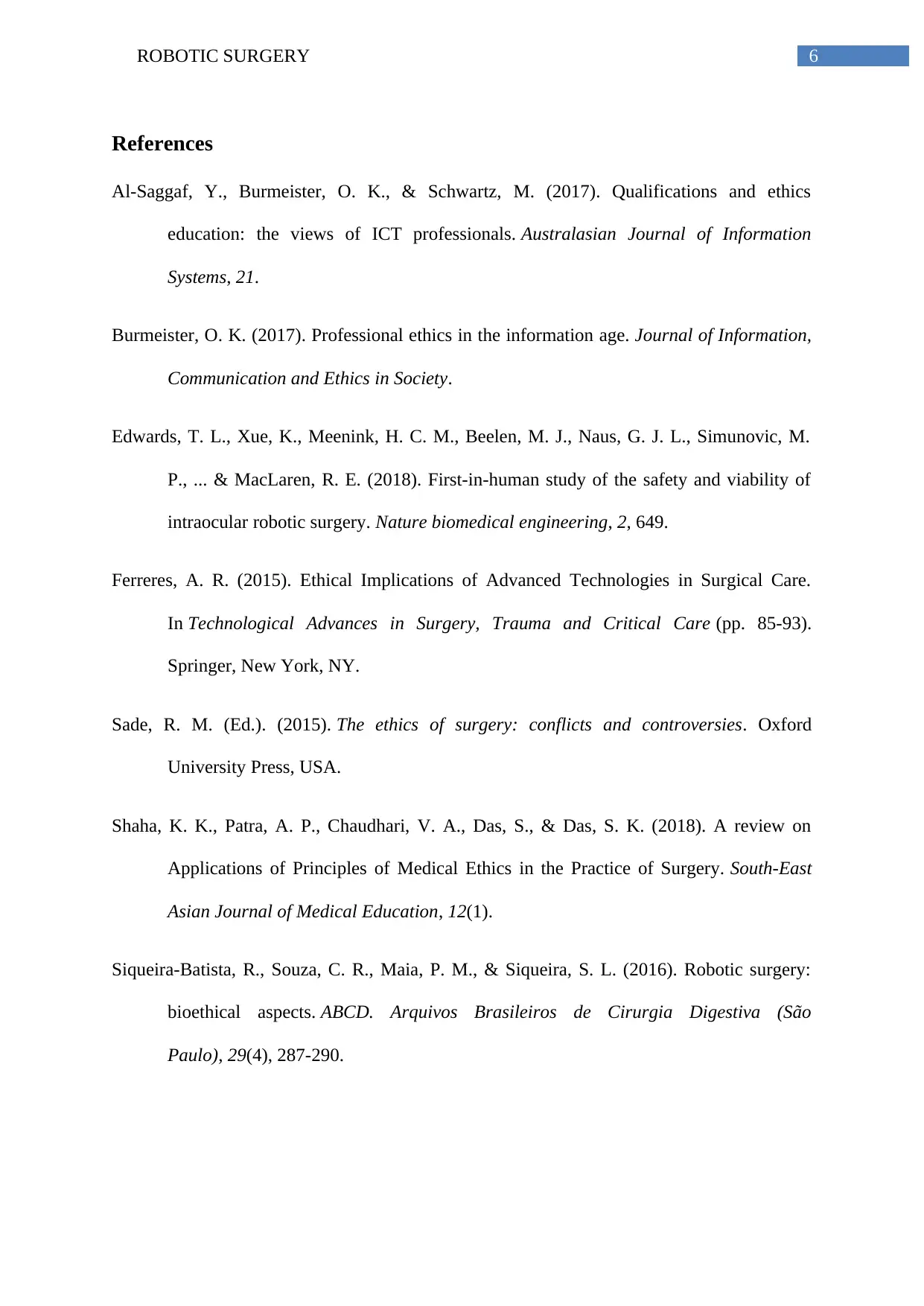
6ROBOTIC SURGERY
References
Al-Saggaf, Y., Burmeister, O. K., & Schwartz, M. (2017). Qualifications and ethics
education: the views of ICT professionals. Australasian Journal of Information
Systems, 21.
Burmeister, O. K. (2017). Professional ethics in the information age. Journal of Information,
Communication and Ethics in Society.
Edwards, T. L., Xue, K., Meenink, H. C. M., Beelen, M. J., Naus, G. J. L., Simunovic, M.
P., ... & MacLaren, R. E. (2018). First-in-human study of the safety and viability of
intraocular robotic surgery. Nature biomedical engineering, 2, 649.
Ferreres, A. R. (2015). Ethical Implications of Advanced Technologies in Surgical Care.
In Technological Advances in Surgery, Trauma and Critical Care (pp. 85-93).
Springer, New York, NY.
Sade, R. M. (Ed.). (2015). The ethics of surgery: conflicts and controversies. Oxford
University Press, USA.
Shaha, K. K., Patra, A. P., Chaudhari, V. A., Das, S., & Das, S. K. (2018). A review on
Applications of Principles of Medical Ethics in the Practice of Surgery. South-East
Asian Journal of Medical Education, 12(1).
Siqueira-Batista, R., Souza, C. R., Maia, P. M., & Siqueira, S. L. (2016). Robotic surgery:
bioethical aspects. ABCD. Arquivos Brasileiros de Cirurgia Digestiva (São
Paulo), 29(4), 287-290.
References
Al-Saggaf, Y., Burmeister, O. K., & Schwartz, M. (2017). Qualifications and ethics
education: the views of ICT professionals. Australasian Journal of Information
Systems, 21.
Burmeister, O. K. (2017). Professional ethics in the information age. Journal of Information,
Communication and Ethics in Society.
Edwards, T. L., Xue, K., Meenink, H. C. M., Beelen, M. J., Naus, G. J. L., Simunovic, M.
P., ... & MacLaren, R. E. (2018). First-in-human study of the safety and viability of
intraocular robotic surgery. Nature biomedical engineering, 2, 649.
Ferreres, A. R. (2015). Ethical Implications of Advanced Technologies in Surgical Care.
In Technological Advances in Surgery, Trauma and Critical Care (pp. 85-93).
Springer, New York, NY.
Sade, R. M. (Ed.). (2015). The ethics of surgery: conflicts and controversies. Oxford
University Press, USA.
Shaha, K. K., Patra, A. P., Chaudhari, V. A., Das, S., & Das, S. K. (2018). A review on
Applications of Principles of Medical Ethics in the Practice of Surgery. South-East
Asian Journal of Medical Education, 12(1).
Siqueira-Batista, R., Souza, C. R., Maia, P. M., & Siqueira, S. L. (2016). Robotic surgery:
bioethical aspects. ABCD. Arquivos Brasileiros de Cirurgia Digestiva (São
Paulo), 29(4), 287-290.
Paraphrase This Document
Need a fresh take? Get an instant paraphrase of this document with our AI Paraphraser
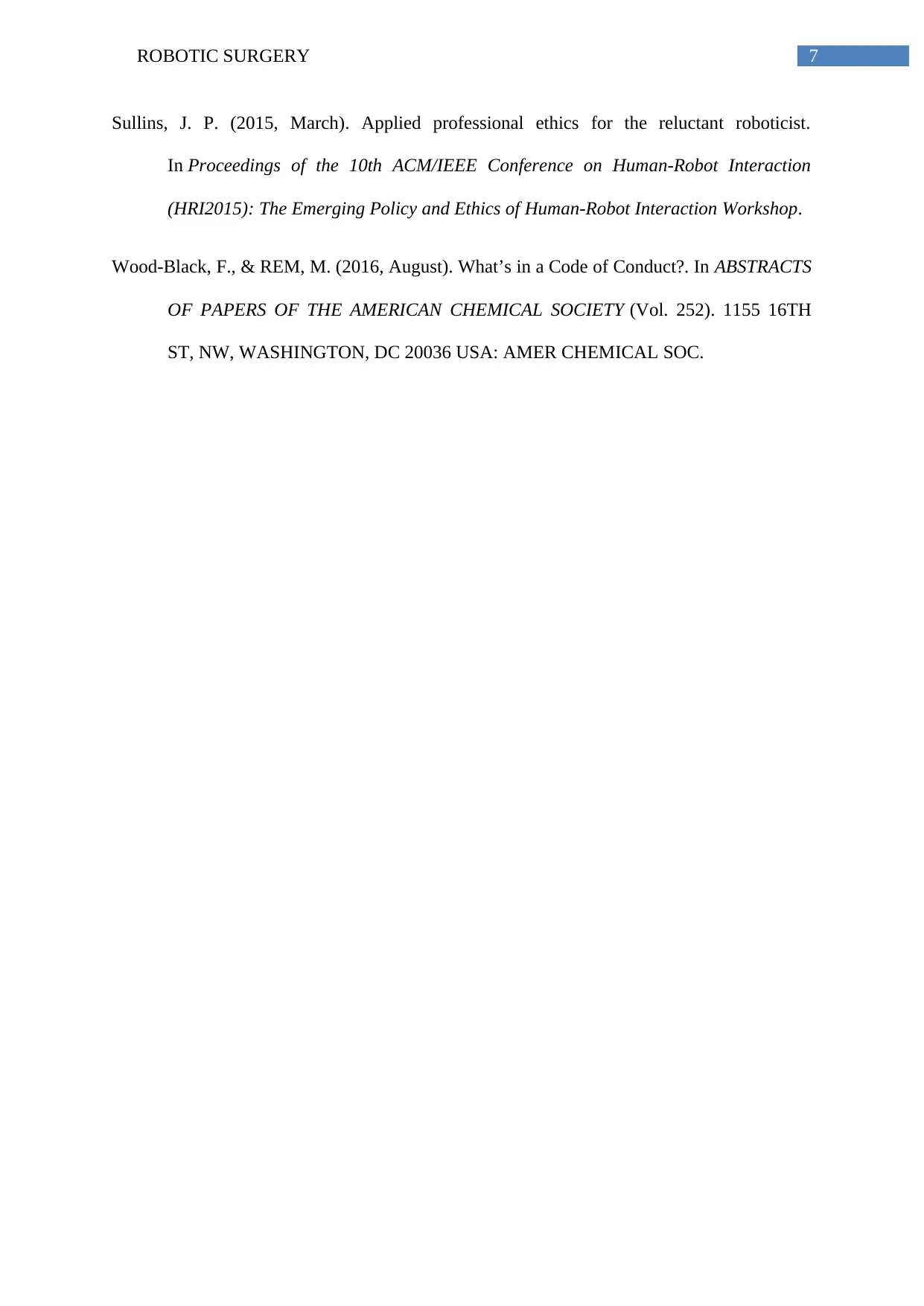
7ROBOTIC SURGERY
Sullins, J. P. (2015, March). Applied professional ethics for the reluctant roboticist.
In Proceedings of the 10th ACM/IEEE Conference on Human-Robot Interaction
(HRI2015): The Emerging Policy and Ethics of Human-Robot Interaction Workshop.
Wood-Black, F., & REM, M. (2016, August). What’s in a Code of Conduct?. In ABSTRACTS
OF PAPERS OF THE AMERICAN CHEMICAL SOCIETY (Vol. 252). 1155 16TH
ST, NW, WASHINGTON, DC 20036 USA: AMER CHEMICAL SOC.
Sullins, J. P. (2015, March). Applied professional ethics for the reluctant roboticist.
In Proceedings of the 10th ACM/IEEE Conference on Human-Robot Interaction
(HRI2015): The Emerging Policy and Ethics of Human-Robot Interaction Workshop.
Wood-Black, F., & REM, M. (2016, August). What’s in a Code of Conduct?. In ABSTRACTS
OF PAPERS OF THE AMERICAN CHEMICAL SOCIETY (Vol. 252). 1155 16TH
ST, NW, WASHINGTON, DC 20036 USA: AMER CHEMICAL SOC.
1 out of 8
Related Documents
Your All-in-One AI-Powered Toolkit for Academic Success.
+13062052269
info@desklib.com
Available 24*7 on WhatsApp / Email
![[object Object]](/_next/static/media/star-bottom.7253800d.svg)
Unlock your academic potential
Copyright © 2020–2025 A2Z Services. All Rights Reserved. Developed and managed by ZUCOL.





